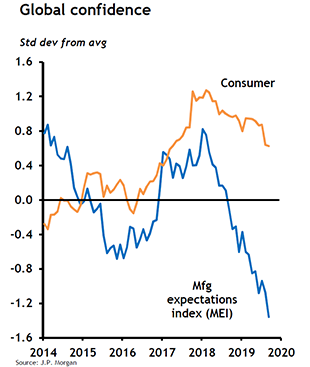Despite what many would consider a tumultuous past few months, world stock
markets rallied from late August lows to finish slightly higher for the third quarter
of 2019. In the US, the S&P 500 inched up 1.2% for a YTD gain of 19%, extending the
longest bull market on record. Developed international markets declined slightly while
emerging markets continued to lag. Bonds settled higher with the yield on the 10 US
Treasury bond falling to 1.67%, highlighting a rare instance where both risk assets and
safe assets increased in value, reflecting investor’s unease with the path of the global
economy.
|
|
3rd Quarter
2019 |
YTD
2019 |
| S&P 500 |
1.70% |
20.55% |
| Russell 2000 |
-2.40% |
14.18% |
| MSCI EAFE (Net) |
-1.07% |
12.80% |
| MSCI Emerging Markets (Net) |
-4.25% |
5.90% |
| Bloomberg Barclay's U.S. Aggregate Bond |
2.27% |
8.52% |
| Source: Zephyr StyleADVISOR |
Through the end of 2019, investors will likely focus their attention on three primary
areas: the global economy, trade issues and what the US Federal Reserve (the Fed)
may do. Although each can be viewed on a stand-alone basis, the interplay between
them may have a meaningful impact on market returns across all asset classes.
While the US economy remains on a stronger footing than most of its international peers, worldwide economic growth is
clearly slowing. Europe’s economy may have ground to a halt with recent measures of business activity the lowest in 6
years. China’s economy has also continued to slow, albeit to a rate that is still outpacing other major developed nations.
Forecasts of GDP for the US have continued to decline but are not yet indicating an elevated probability of imminent
recession, even though a recent Wall Street Journal poll of economists suggests that the manufacturing sector is in
recession and the service sector is posting much slower growth. And what do market observers point to as a primary
drag on economic growth? Trade uncertainty.
Trade issues have dominated the financial headlines for much of 2019 and the third quarter was no exception. A resolution
to the trade dispute between China and the US has proven elusive and the fit-and-start nature of negotiations has been
disruptive to businesses worldwide. In the US, agriculture has been especially hard hit with implications for farmers and
ancillary businesses like manufacturing and transportation. While China has recently stepped up purchases of some
agricultural products like soybeans, shipments remain far short of pre-trade war levels. Some wonder if China is merely
trying to buy their way out of the trade dispute rather than address the structural reforms that the US is insisting upon.

For many, the seemingly ad hoc nature of tariff impositions
and the tit-for-tat response by each nation has created an
atmosphere of uncertainty that has left many businesses
unwilling to commit capital to business expansion,
exacerbating the economic growth issues highlighted
above. All of this has not gone unnoticed by the Federal
Reserve.
The third quarter was a busy one for the Fed with cuts to
interest rates in both July and September in an attempt to
prolong the economic expansion. Just a year earlier the
Fed was raising rates but has now joined along with 16
other central banks in lowering rates in the third quarter.
A recent release of notes from the September Fed meeting
show officials growing more concerned about weakness
from trade and slowing global growth and the deleterious
effect they may have on domestic hiring. Job growth has
slowed as of late but remains steady and wage pressures
are muted. Those factors along with a lack of inflation
pressure may mean that the Fed has room to comfortably
reduce interest rates further - although the amount and
timing of further cuts is an open issue as a minority of Fed
members questioned whether any additional cuts were
needed at all. Above all, the Federal Reserve needs to
maintain its independent role and not allow its decisions to
be influenced by other government entities.
Markets enter the fourth quarter in a somewhat fragile state
and it’s important that investors not get caught up in the
noise being generated on a daily basis. A well-diversified
investment portfolio that is rebalanced periodically and
structured for long-term results is a great antidote to the
impulse to react (or over-react) to the 24/7 news cycle. It is
also a great time to meet with your advisor to ensure that
you’re well-positioned for 2020 and to discuss any tax or
planning issues before year-end.
Data as of 9/30/19
This material is provided for general information purposes only. Investments and insurance products are not FDIC insured, not bank deposits, not obligations of, or guaranteed by Canandaigua National Bank & Trust or any of its affiliates. Investments are subject to investment risks, including possible loss of principal amount invested. Past performance is not indicative of future investment results. Before making any investment decision, please consult your legal, tax or financial advisor. Investments and services may be offered through affiliate companies.